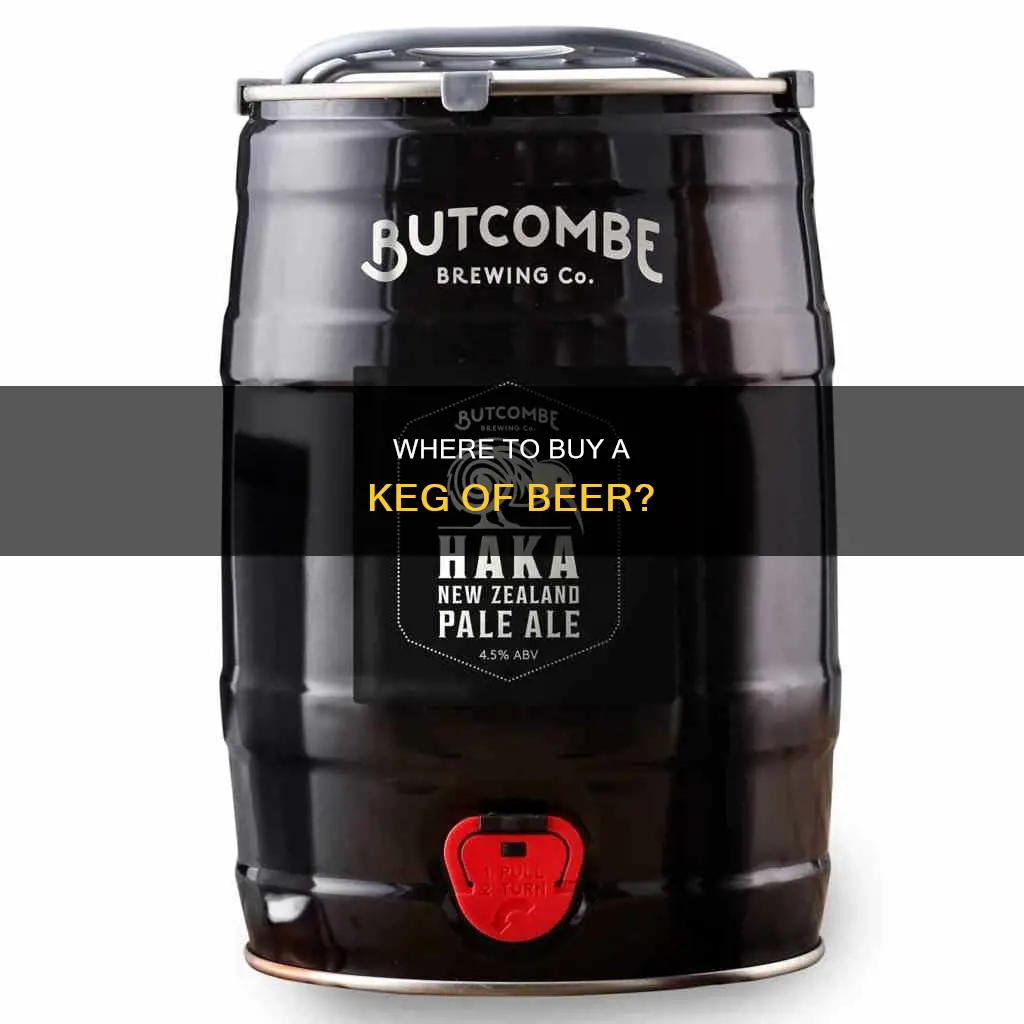
Buying a keg of beer is a great option for parties and events. There are a variety of keg sizes available, ranging from mini kegs to full-sized kegs, which can serve about 165 drinks. You can typically purchase kegs from liquor stores, breweries, or even some restaurants, and it's recommended to place your order in advance to ensure availability. When picking up the keg, don't forget to bring proper identification, as most places will require you to be at least 21 years old. Additionally, you will need to pay a deposit for the keg, which can range from $30 to $75 or more, and may include additional rental fees for accessories like taps and chilling buckets. It's also important to plan for transportation, as kegs can be heavy, and to have a strategy for keeping the beer cold and reducing foaminess.
| Characteristics | Values |
|---|---|
| Keg Sizes | Half barrel, quarter barrel, sixth barrel, Cornelius keg, mini-keg |
| Number of Beers in a Keg | 14 to 165 12-ounce beers |
| Keg Couplers | A, D, G, M, S, and U |
| Keg Cost | Varies depending on the size and brand of beer |
| Keg Weight | A full keg weighs roughly 162 pounds |
| Keg Life | 6 to 8 weeks before it starts to taste flat |
What You'll Learn

Keg prices and where to buy them
The price of a keg of beer depends on several factors, including the size and brand of the keg. A full-size keg (half-barrel) typically holds 15.5 gallons or 165 12-ounce beers and can cost anywhere from $79 to $220 or more, depending on the brand and market. For example, a half keg of Dos Equis Amber may cost around $158 plus a deposit, while a half keg of Stieglitz Grapefruit may cost around $220 plus deposit. The deposit is usually small, around $15.
When purchasing a keg, it is essential to consider the number of people at your event and their drinking preferences. A full-size keg can serve about 165 beers, while a quarter-barrel (pony keg) serves about 83 12-ounce beers.
Kegs can be purchased from various places, including liquor stores, breweries, wineries, and even some restaurants. It is recommended to call and place your order in advance to ensure availability. Large liquor retailers like "Liquor Barn" may offer more competitive prices, but smaller local retailers might be more convenient and save you money on transportation.
Additionally, some establishments offer rentals of accessories like taps, chilling buckets, and kegerators, which are refrigerators designed specifically for kegs. These rentals typically require refundable deposits and may include non-refundable cleaning fees.
When picking up the keg, don't forget to bring a government-issued ID and a credit card for the deposit. Most places will also require you to sign paperwork accepting responsibility for the keg and its safe and timely return.
By following these guidelines and planning ahead, you can ensure a steady supply of beer for your event and a positive experience overall.
Shiner Prickly Pear Beer: Where to Buy This Seasonal Treat
You may want to see also

How much beer is in a keg
The amount of beer in a keg depends on the size of the keg. The most common keg sizes are the mini keg, Cornelius keg, sixth-barrel, quarter-barrel, and half-barrel. A mini keg, also known as a Bubba Keg, holds 14 12-ounce pours. A Cornelius keg, also known as a Home Brew Keg, Pepsi Keg, or Corny Keg, holds 53 12-ounce pours. A sixth-barrel, also known as a Sixtel or Log, holds 55 12-ounce pours. A quarter-barrel, also known as a Pony Keg or Stubby Quarter, holds 83 12-ounce pours. A half-barrel, also known as a Full-Size Keg or Full Keg, holds 165 12-ounce pours.
In addition to these common sizes, there are also 30-liter and 50-liter kegs. A 30-liter keg holds 86 12-ounce pours, while a 50-liter keg holds 140 12-ounce pours.
When planning to purchase a keg, it is important to consider the number of people who will be served and the duration of the event. A mini keg is suitable for a small gathering or portable applications, while a Cornelius keg is a popular choice for homebrewers. The sixth-barrel, quarter-barrel, and half-barrel are often used for small to medium-sized parties, with the half-barrel being the most common type for large events, college parties, and bars.
Red Dog Beer: Still Available for Purchase?
You may want to see also

How to store a keg
Storing a keg of beer requires a bit of preparation and careful handling. Here are some detailed instructions to ensure your keg stays fresh and ready to serve:
Keep the Keg Cold
Maintain a consistent temperature for your keg, ideally at around 38°F (3°C). You can use a chilling bucket filled with ice or a kegerator (a refrigerator designed for kegs) to achieve this. Alternatively, place the keg in a large garbage bag and fill it with ice. Avoid letting the temperature go above 55°F (12.8°C) or below 28°F (-2.2°C), as this can affect the beer's quality.
Don't Move the Keg
After you've placed the keg in the desired location, let it settle for at least an hour before tapping it. Moving the keg around can affect the beer's quality, so it's best to keep it in one place.
Consume the Beer Within a Suitable Time Frame
The type of tap you use will influence how long the beer stays fresh. A manual pump will reduce the beer's taste quality, so it's best to consume the beer within 8 hours to a day. If you're using a kegerator and CO2 to dispense the beer, pasteurized beer can last up to 3 months, while unpasteurized beer can last about 2 months.
Maintain Consistent Pressure
Keep the pressure in the keg at an optimal level, typically between 10-12 psi. If the pressure is too low, the beer will come out foamy and flat. On the other hand, if the pressure is too high, the beer will pour too fast and still end up flat.
First In, First Out (FIFO)
If you have multiple kegs, make sure to use the oldest ones first. Enjoy your beer as fresh as possible and save the newly stored ones for later.
Buying Beer on Sundays in Ohio: What's the Deal?
You may want to see also

Keg taps and accessories
When it comes to keg taps and accessories, there are a few things you need to know. Firstly, different types of beer require different types of keg couplers. Keg couplers are usually labelled with letters, with the most common types being A, D, G, M, S, and U. The type of coupler you need depends on the beer you're serving. For instance, a D Coupler is suitable for North American kegs, an S Coupler for most European kegs, and a G Coupler for a few European kegs.
Keg taps, also known as keg pumps, are essential for dispensing beer from a keg. You can choose between manually pumping the beer yourself or using CO2 to do the work for you. When renting or buying a keg tap, ensure it comes with a coupler suitable for your beer.
In addition to keg taps, you may also want to consider renting or purchasing the following accessories:
- A chilling bucket or kegerator to keep the keg cold.
- A jockey box, a mini cooler with tubing that connects to the keg and a tap, instantly chilling the beer as it is dispensed.
- A CO2 tank, pressure regulator, and connection lines to carbonate and dispense the beer from the keg.
- Glassware and other serving accessories.
Estrella Galicia Beer: Where to Buy and Enjoy It
You may want to see also

Returning a keg
Empty the Keg
It is recommended that you empty the keg before returning it. While you won't get a refund for the beer, you've already paid for it, so you might as well enjoy it. Additionally, some stores specifically request that kegs be returned empty.
Remove the Tap
Before transporting the keg, make sure to detach the tap. Keeping the tap attached may be considered having an open container in your vehicle, which is illegal in the U.S.
Return the Keg by the Deadline
Most places will give you a deadline for returning the keg, which is typically around 5 days to 2 weeks. Make sure you return the keg within this timeframe to avoid any issues or additional fees.
Return the Keg to the Original Vendor
Kegs should always be returned to the place where you obtained them. The keg remains the property of the original vendor, and returning it to a different store will likely result in your deposit being rejected due to keg registration laws.
Return All Rented Accessories
If you rented any accessories, such as a tap or a chilling bucket, make sure to return them along with the keg. This will ensure that you receive any refundable fees associated with the keg and its accessories.
Ensure the Identifying Sticker is Intact
The store will have placed an identifying sticker on the keg when you picked it up. This sticker is necessary for the store to confirm that the returned keg is the one that was rented out.
Return the Keg in Good Condition
When you rented the keg, you signed paperwork accepting responsibility for its condition. Make sure the keg and all rented items are returned in the same condition as when you received them to avoid any additional charges or issues.
Return the Keg as the Same Person
When renting the keg, you likely provided the name of the person who would be returning it. The store may refuse to accept the keg if it is returned by someone else, as they want to ensure it is returned by someone of legal age.
Know the Laws in Your State
Different states have varying laws regarding keg registration, possession, and scrap value. Familiarize yourself with the laws in your state to avoid any legal issues when returning or disposing of a keg.
Treehouse Beer: Where to Buy and What to Know
You may want to see also
Frequently asked questions
You can buy a keg of beer from a local microbrewery, liquor store, or online.
The cost of a keg of beer depends on the size and brand of beer. For example, a half keg of Dos Equis Amber costs about $158 plus a deposit, while a half keg of Stieglitz Grapefruit is $220 plus deposit.
The number of beers in a keg depends on the size of the keg. A keg can hold anywhere from 14 to 165 12-ounce beers.
If kept cold, a keg of beer can last up to six to eight weeks before it starts to taste flat. Pasteurized beer that is kept chilled will last even longer, up to six months.







